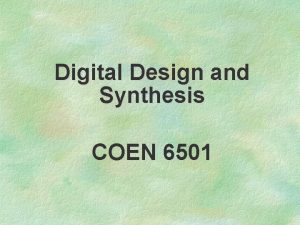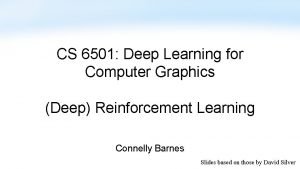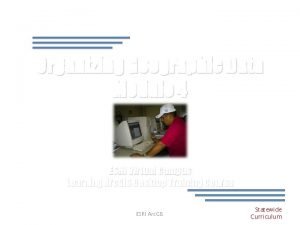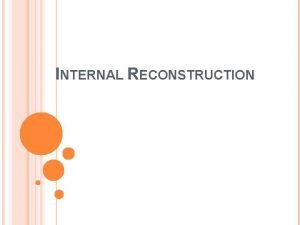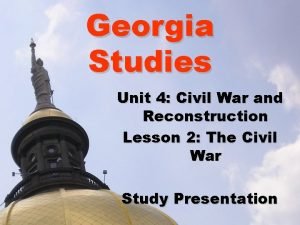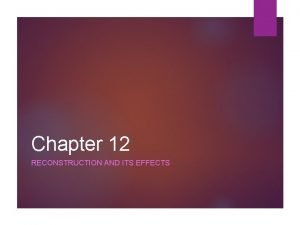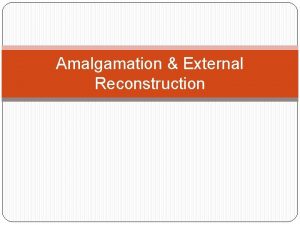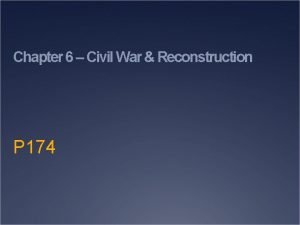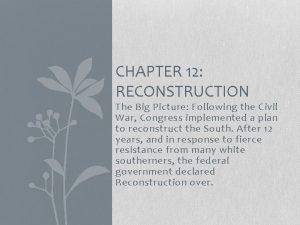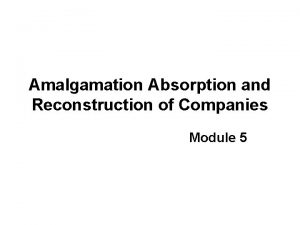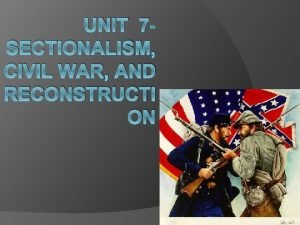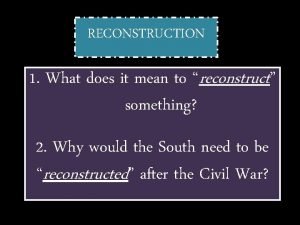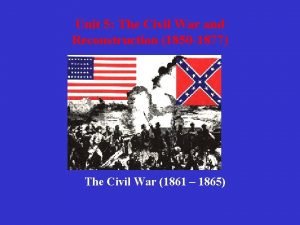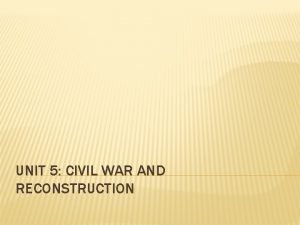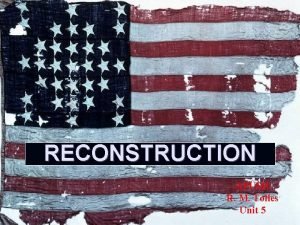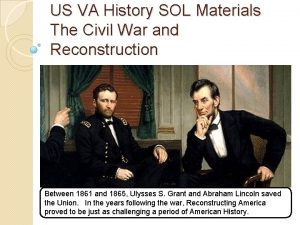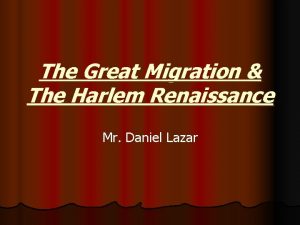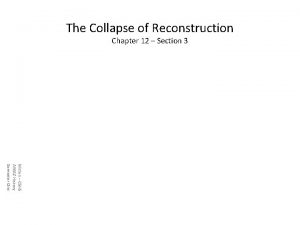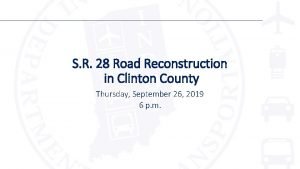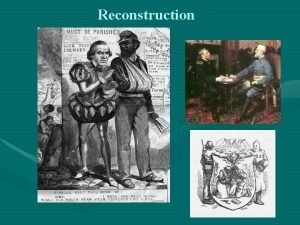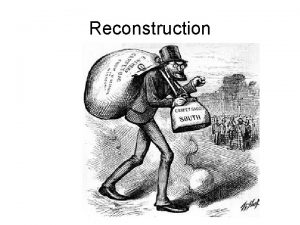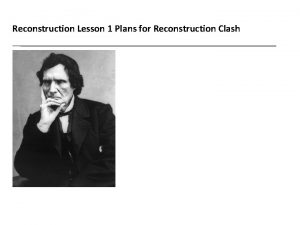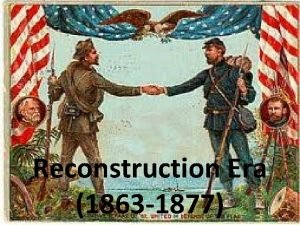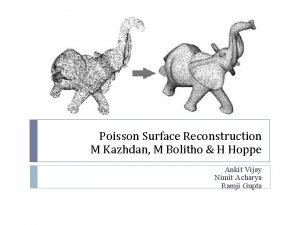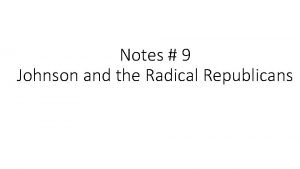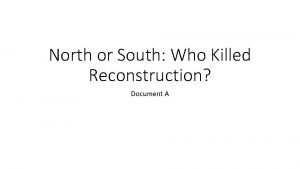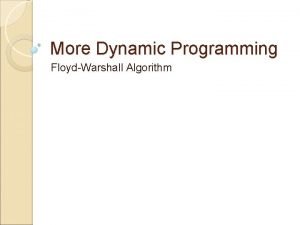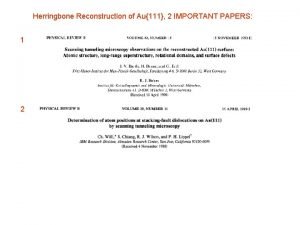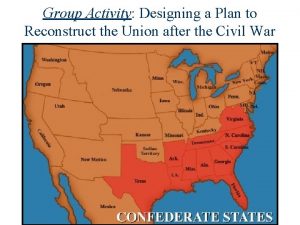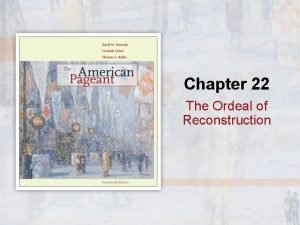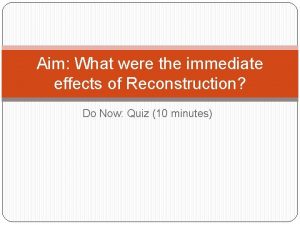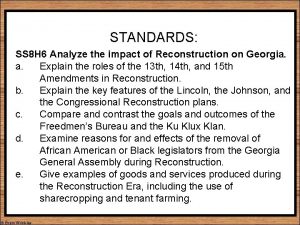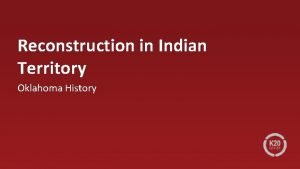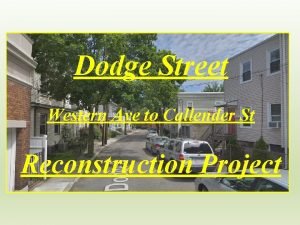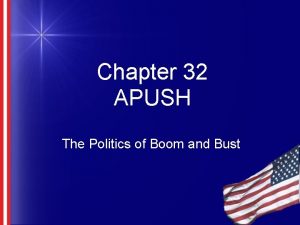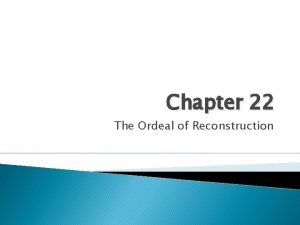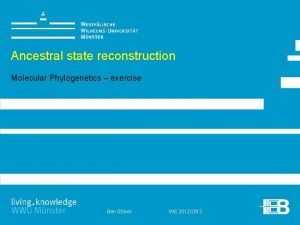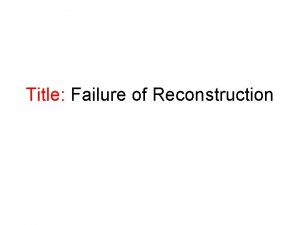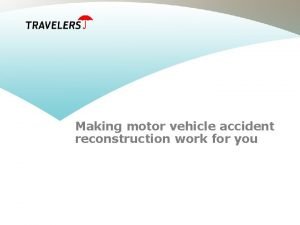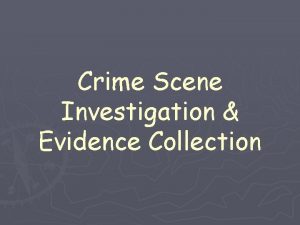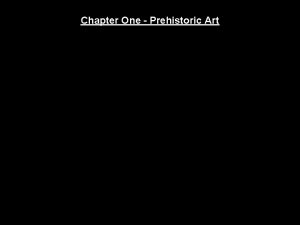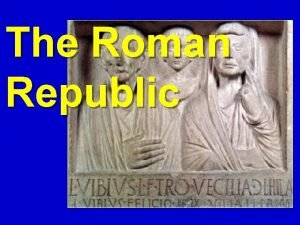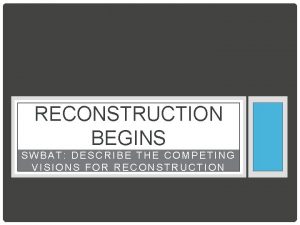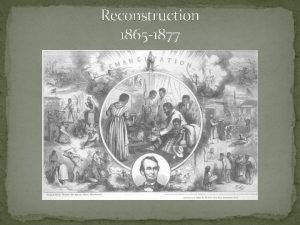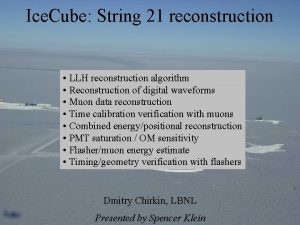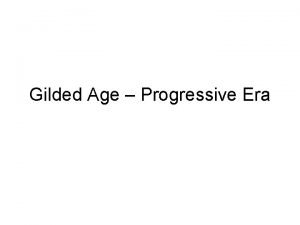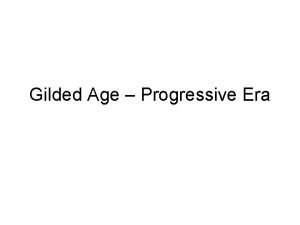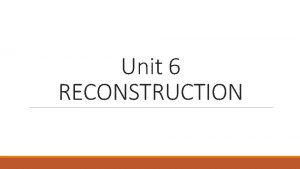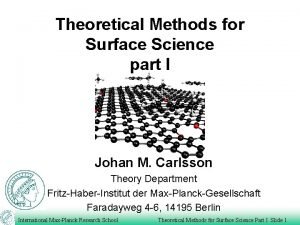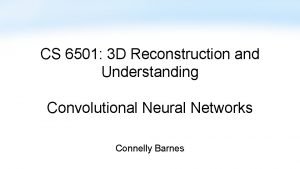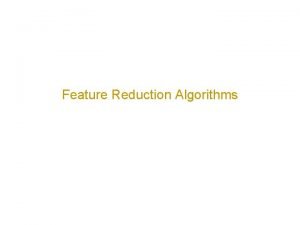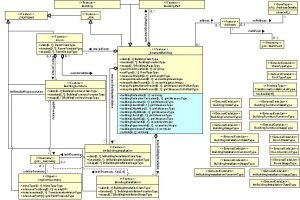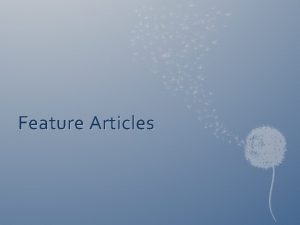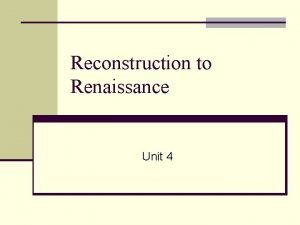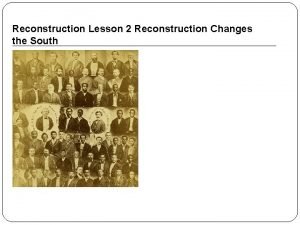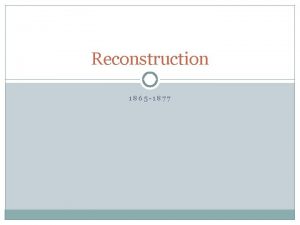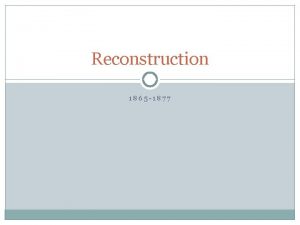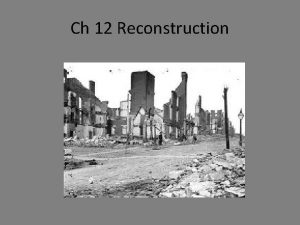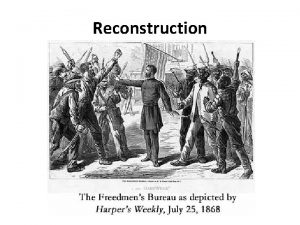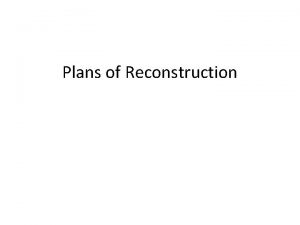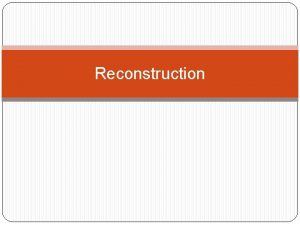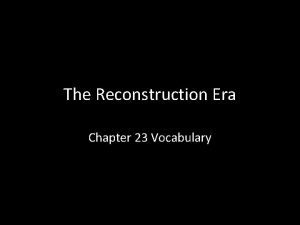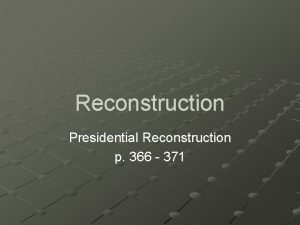CS 6501 3 D Reconstruction and Understanding Feature
























![Gaussian Pyramids Known as a Gaussian Pyramid [Burt and Adelson, 1983] • In computer Gaussian Pyramids Known as a Gaussian Pyramid [Burt and Adelson, 1983] • In computer](https://slidetodoc.com/presentation_image_h2/eefa8e3e45011885b28fec6b5c07309b/image-25.jpg)















![Feature-space outlier rejection • From [Lowe, 1999]: • 1 -NN: SSD of the closest Feature-space outlier rejection • From [Lowe, 1999]: • 1 -NN: SSD of the closest](https://slidetodoc.com/presentation_image_h2/eefa8e3e45011885b28fec6b5c07309b/image-41.jpg)













![Hough Transform: Effect of Noise [Forsyth & Ponce] Hough Transform: Effect of Noise [Forsyth & Ponce]](https://slidetodoc.com/presentation_image_h2/eefa8e3e45011885b28fec6b5c07309b/image-55.jpg)





























- Slides: 84

CS 6501: 3 D Reconstruction and Understanding Feature Detection and Matching Connelly Barnes Slides from Jason Lawrence, Fei Li, Juan Carlos Niebles, Alexei Efros, Rick Szeliski, Fredo Durand, Kristin Grauman, James Hays

Outline • • • Motivation for sparse features Harris corner detector Difference of Gaussian (blob) feature detector Sparse feature descriptor: SIFT Robust model fitting • Hough transform • RANSAC • Application: panorama stitching

Motivation: Image Matching (Hard Problem) Slide from Fei Li, Juan Carlos Niebles

Motivation: Image Matching (Harder Case) Slide from Fei Li, Juan Carlos Niebles, Steve Seitz

What is a Feature? • In computer vision, a feature refers to a region of interest in an image: typically, low-level features, such as corner, edge, blob. Corner features Slide from Krystian Mikolajczyk

Motivation for sparse/local features • Global features can only summarize the overall content of the image. • Local (or sparse) features can allow us to match local regions with more geometric accuracy. • Increased robustness to: Slide from Fei Li, Juan Carlos Niebles

Motivating Application: Panorama Stitching • Are you getting the whole picture? • Compact Camera FOV = 50 x 35° Slide from Brown & Lowe

Motivating Application: Panorama Stitching • Are you getting the whole picture? • Compact Camera FOV = 50 x 35° • Human FOV = 200 x 135° Slide from Brown & Lowe

Motivating Application: Panorama Stitching • Are you getting the whole picture? • Compact Camera FOV = 50 x 35° • Human FOV = 200 x 135° • Panoramic Mosaic = 360 x 180° Slide from Brown & Lowe

Mosaics: stitching images together virtual wide-angle camera

Image Alignment • How do we align two images automatically? • Two broad approaches: • Feature-based alignment • Find a few matching features in both images • Compute alignment • Direct (pixel-based) alignment • Search for alignment where most pixels agree • High computation requirements if many unknown alignment parameters

Feature-based Panorama Stitching • Find corresponding feature points • Fit a model placing the two images in correspondence • Blend / cut ?

Feature-based Panorama Stitching • Find corresponding feature points • Fit a model placing the two images in correspondence • Blend / cut

Feature-based Panorama Stitching • Find corresponding feature points • Fit a model placing the two images in correspondence • Blend / cut

Requirements for the Features

Requirements for the Features

Outline • • • Motivation for sparse features Harris corner detector Difference of Gaussian (blob) feature detector Sparse feature descriptor: SIFT Robust model fitting • Hough transform • RANSAC • Application: panorama stitching

Harris Corner Detector: Basic Idea • We should easily recognize the point by looking through a small window • Shifting a window in any direction should give a large change in intensity

Harris Corner Detector: Basic Idea “flat” region: no change in all directions “edge”: no change along the edge direction “corner”: significant change in all directions

Gradient covariance matrix Summarizes second-order statistics of the gradient (Fx, Fy) in a window u = -m … m, v = -m … m around the center pixel (x, y).

Harris Detector: Mathematics Classification of image points using eigenvalues of M: 2 “Edge” 2 >> 1 “Corner” 1 and 2 are large, 1 ~ 2; E increases in all directions 1 and 2 are small; E is almost constant in all directions “Flat” region “Edge” 1 >> 2 1

Applications of Corner Detectors

Applications of Corner Detectors • Augmented reality (video puppetry) • 3 D photography / light fields

Outline • • • Motivation for sparse features Harris corner detector Difference of Gaussian (blob) feature detector Sparse feature descriptor: SIFT Robust model fitting • Hough transform • RANSAC • Application: panorama stitching
![Gaussian Pyramids Known as a Gaussian Pyramid Burt and Adelson 1983 In computer Gaussian Pyramids Known as a Gaussian Pyramid [Burt and Adelson, 1983] • In computer](https://slidetodoc.com/presentation_image_h2/eefa8e3e45011885b28fec6b5c07309b/image-25.jpg)
Gaussian Pyramids Known as a Gaussian Pyramid [Burt and Adelson, 1983] • In computer graphics, a mip map [Williams, 1983] • A precursor to wavelet transform Slide by Steve Seitz

To generate the next level in the pyramid: 1. Filter with Gaussian filter (blurs image) Typical filter: 1/16 2/16 4/16 2/16 1/16 2. Discard every other row and column (nearest neighbor subsampling). Figure from David Forsyth

What are they good for? • Improve Search • Search over translations • E. g. convolve with a filter of what we are looking for (circle filter? ) • Can use “coarse to fine” search: discard regions that are not of interest at coarse levels. • Search over scale • Template matching • E. g. find a face at different scales • Pre-computation • Need to access image at different blur levels • Useful for texture mapping at different resolutions (called mip-mapping)

Difference of Gaussians Feature Detector • Idea: Find blob regions of various sizes • Approach: • Run linear filter (Difference of Gaussians) • At different resolutions of image pyramid • Often used for computing SIFT. “SIFT” = Do. G detector + SIFT descriptor 28

Difference of Gaussians Minus Gaussian with parameter Kσ Gaussian with parameter σ Equals 29 Typical K = 1. 6

Non-maxima (non-minima) suppression • Detect maxima and minima of difference-of. Gaussian in scale space For local maximum, how should the value of X be related to the value of the green circles? 30

Difference of Gaussian Detected Keypoints Image from Ravimal Bandara at Code. Project

Outline • • • Motivation for sparse features Harris corner detector Difference of Gaussian (blob) feature detector Sparse feature descriptor: SIFT Robust model fitting • Hough transform • RANSAC • Application: panorama stitching

Feature Descriptors • We know how to detect points (corners, blobs) • Next question: How to match them? ? Point descriptor should be: 1. Invariant 2. Distinctive

Descriptors Invariant to Rotation • Find local orientation • Make histogram of 36 different angles (10 degree increments). • Vote into histogram based on magnitude of gradient. • Detect peaks from histogram. Dominant direction of gradient • Extract image patches relative to this orientation

SIFT Keypoint: Orientation • Orientation = dominant gradient • Rotation Invariant Frame • Scale-space position (x, y, s) + orientation ( )

SIFT Descriptor (A Feature Vector) • Image gradients are sampled over 16 x 16 array of locations. • Find gradient angles relative to keypoint orientation (in blue) • Accumulate into array of orientation histograms • 8 orientations x 4 x 4 histogram array = 128 dimensions Keypoint 36

SIFT Descriptor (A Feature Vector) • Often “SIFT” = • Difference of Gaussian keypoint detector, plus • SIFT descriptor • But you can also use SIFT descriptor computed at other locations (e. g. at Harris corners, at every pixel, etc) • More details: Lowe 2004 (especially Sections 3 -6)

Feature Matching ?

Feature Matching • Exhaustive search • for each feature in one image, look at all the other features in the other image(s) • Hashing (see locality sensitive hashing) • Project into a lower k dimensional space, e. g. by random projections, use that as a “key” for a k-d hash table, e. g. k=5. • Nearest neighbor techniques • kd-trees (available in libraries, e. g. Sci. Py, Open. CV, FLANN, Faiss).

What about outliers? ?
![Featurespace outlier rejection From Lowe 1999 1 NN SSD of the closest Feature-space outlier rejection • From [Lowe, 1999]: • 1 -NN: SSD of the closest](https://slidetodoc.com/presentation_image_h2/eefa8e3e45011885b28fec6b5c07309b/image-41.jpg)
Feature-space outlier rejection • From [Lowe, 1999]: • 1 -NN: SSD of the closest match • 2 -NN: SSD of the second-closest match • Look at how much better 1 -NN is than 2 -NN, e. g. 1 -NN/2 -NN • That is, is our best match so much better than the rest? • Reject if 1 -NN/2 -NN > threshold.

Feature-space outlier rejection • Can we now compute an alignment from the blue points? (the ones that survived the “feature space outlier rejection” test) • No! Still too many outliers… • What can we do?

Outline • • • Motivation for sparse features Harris corner detector Difference of Gaussian (blob) feature detector Sparse feature descriptor: SIFT Robust model fitting • Hough transform • RANSAC • Application: panorama stitching

Model fitting • Fitting: find the parameters of a model that best fit the data • Alignment: find the parameters of the transformation that best align matched points Slide from James Hays

Example: Aligning Two Photographs

Example: Estimating a transformation H Slide from Silvio Savarese

Example: fitting a 3 D object model Slide from Silvio Savarese

Critical issues: outliers H Slide from Silvio Savarese

Critical issues: missing data (occlusions) Slide from Silvio Savarese

Non-robust Model Fitting • Least squares fit with an outlier: Problem: squared error heavily penalizes outliers

Outline • • • Motivation for sparse features Harris corner detector Difference of Gaussian (blob) feature detector Sparse feature descriptor: SIFT Robust model fitting • Hough transform • RANSAC • Application: panorama stitching

Hough transform P. V. C. Hough, Machine Analysis of Bubble Chamber Pictures, Proc. Int. Conf. High Energy Accelerators and Instrumentation, 1959 • Suppose we want to fit a line. • For each point, vote in “Hough space” for all lines that the point may belong to. y m x y=mx+b Hough space b Slide from S. Savarese

Hough transform y m b x y m 3 x Slide from S. Savarese 5 3 3 2 2 3 7 11 10 4 3 2 1 1 0 5 3 2 3 4 1 b

Hough transform P. V. C. Hough, Machine Analysis of Bubble Chamber Pictures, Proc. Int. Conf. High Energy Accelerators and Instrumentation, 1959 Issue : parameter space [m, b] is unbounded… Use a polar representation for the parameter space y x Hough space Slide from S. Savarese
![Hough Transform Effect of Noise Forsyth Ponce Hough Transform: Effect of Noise [Forsyth & Ponce]](https://slidetodoc.com/presentation_image_h2/eefa8e3e45011885b28fec6b5c07309b/image-55.jpg)
Hough Transform: Effect of Noise [Forsyth & Ponce]

Hough Transform: Effect of Noise Need to set grid / bin size based on amount of noise [Forsyth & Ponce]

Discussion • Could we use Hough transform to fit: • Diamonds of a known size? • What kinds of points would we first detect? • What are the dimensions that we would “vote” in? • Diamonds of unknown size? • What are the dimensions that we would “vote” in? • Ellipses?

Hough Transform Conclusions • Pros: • Robust to outliers • Cons: • Bin size has to be set carefully to trade of noise/precision/memory • Grid size grows exponentially in number of parameters Slide from James Hays

RANSAC (RANdom SAmple Consensus) : Fischler & Bolles in ‘ 81. Algorithm: 1. Sample (randomly) the number of points required to fit the model 2. Solve for model parameters using samples 3. Score by the fraction of inliers within a preset threshold of the model Repeat 1 -3 until the best model is found with high confidence

RANSAC Line fitting example Algorithm: 1. Sample (randomly) the number of points required to fit the model (#=2) 2. Solve for model parameters using samples 3. Score by the fraction of inliers within a preset threshold of the model Repeat 1 -3 until the best model is found with high confidence Illustration by Savarese

RANSAC Line fitting example Algorithm: 1. Sample (randomly) the number of points required to fit the model (#=2) 2. Solve for model parameters using samples 3. Score by the fraction of inliers within a preset threshold of the model Repeat 1 -3 until the best model is found with high confidence

RANSAC Line fitting example Algorithm: 1. Sample (randomly) the number of points required to fit the model (#=2) 2. Solve for model parameters using samples 3. Score by the fraction of inliers within a preset threshold of the model Repeat 1 -3 until the best model is found with high confidence

RANSAC Algorithm: 1. Sample (randomly) the number of points required to fit the model (#=2) 2. Solve for model parameters using samples 3. Score by the fraction of inliers within a preset threshold of the model Repeat 1 -3 until the best model is found with high confidence

Choosing the parameters • Initial number of points s • Minimum number needed to fit the model • Distance threshold t • Choose t so probability for inlier is p (e. g. 0. 95) • Zero-mean Gaussian noise with std. dev. σ: t =1. 96σ • Number of iterations N • Choose N so that, with probability p, at least one random sample is free from outliers (e. g. p=0. 99) (outlier ratio: e) proportion of outliers e s 2 3 4 5 6 7 8 5% 2 3 3 4 4 4 5 10% 25% 30% 40% 50% 3 5 6 7 11 17 4 7 9 11 19 35 5 9 13 17 34 72 6 12 17 26 57 146 7 16 24 37 97 293 8 20 33 54 163 588 9 26 44 78 272 1177 Source: M. Pollefeys

RANSAC Conclusions • Pros: • Robust to outliers • Can use models with more parameters than Hough transform • Cons: • Computation time grows quickly with fraction of outliers and number of model parameters Slide from James Hays

Outline • • • Motivation for sparse features Harris corner detector Difference of Gaussian (blob) feature detector Sparse feature descriptor: SIFT Robust model fitting • Hough transform • RANSAC • Application: panorama stitching

Feature-based Panorama Stitching • Find corresponding feature points (SIFT) • Fit a model placing the two images in correspondence • Blend / cut ?

Feature-based Panorama Stitching • Find corresponding feature points • Fit a model placing the two images in correspondence • Blend / cut

Feature-based Panorama Stitching • Find corresponding feature points • Fit a model placing the two images in correspondence • Blend / cut

Aligning Images with Homographies left on top right on top Translations are not enough to align the images

Homographies / maps pixels between cameras at the same position but different rotations. • Example: planar ground textures in classic games (e. g. Super Nintendo Mario Kart) • Any other examples? (Write out matrix multiplication on board for students without linear algebra)

Julian Beever: Manual Homographies http: //users. skynet. be/J. Beever/pave. htm

Homography … … To compute the homography given pairs of corresponding points in the images, we need to set up an equation where the parameters of H are the unknowns…

Solving for homographies p’ = Hp • Can set scale factor i=1. So, there are 8 unknowns. • Set up a system of linear equations: • Ah = b • Where vector of unknowns h = [a, b, c, d, e, f, g, h]T • Multiply everything out so there are no divisions. • Need at least 8 eqs, but the more the better… • Solve for h using least-squares: Matlab: p = A y; Python: p = numpy. linalg. lstsq(A, y)

im 1 im 2

im 1 im 2

im 1 im 2 im 1 warped into reference frame of im 2. Can use skimage. transform. Projective. Transform to ask for the colors (possibly interpolated) from im 1 at all the positions needed in im 2’s reference frame.


Matching features with RANSAC + homography What do we do about the “bad” matches?

RANSAC for estimating homography • 1. 2. 3. 4. 5. RANSAC loop: Select four feature pairs (at random) Compute homography H (exact) Compute inliers where SSD(pi’, H pi) < ε Keep largest set of inliers Re-compute least-squares H estimate on all of the inliers

RANSAC • The key idea is not that there are more inliers than outliers, but that the outliers are wrong in different ways. • “All happy families are alike; each unhappy family is unhappy in its own way. ” – Tolstoy, Anne Karenina

Feature-based Panorama Stitching • Find corresponding feature points • Fit a model placing the two images in correspondence • Blend • Easy blending: for each pixel in the overlap region, use linear interpolation with weights based on distances. • Fancier blending: Poisson blending

Panorama Blending 1. Pick one image (red) 2. Warp the other images towards it (usually, one by one) 3. Blend

Applications • Visual Odometry with Open. CV
 Wampimuk
Wampimuk Coen 6501
Coen 6501 Cs 6501
Cs 6501 Hongning wang
Hongning wang Cs 6501
Cs 6501 Feature dataset vs feature class
Feature dataset vs feature class Isolated feature combined feature effects
Isolated feature combined feature effects Securitization and reconstruction of financial assets
Securitization and reconstruction of financial assets Positives and negatives of reconstruction
Positives and negatives of reconstruction Define internal reconstruction
Define internal reconstruction Unit 4: civil war and reconstruction
Unit 4: civil war and reconstruction Presidential and congressional reconstruction venn diagram
Presidential and congressional reconstruction venn diagram Civil war and reconstruction study guide
Civil war and reconstruction study guide Chapter 12 section 1 the politics of reconstruction
Chapter 12 section 1 the politics of reconstruction Distinguish between amalgamation and reconstruction
Distinguish between amalgamation and reconstruction Chapter 6 civil war and reconstruction
Chapter 6 civil war and reconstruction Why did johnson and congress clash over reconstruction
Why did johnson and congress clash over reconstruction Define amalgamation absorption and reconstruction
Define amalgamation absorption and reconstruction Quizlet
Quizlet Sampling and reconstruction
Sampling and reconstruction Reconstruction and its aftermath
Reconstruction and its aftermath Presidential and radical reconstruction venn diagram
Presidential and radical reconstruction venn diagram Presidential and congressional reconstruction venn diagram
Presidential and congressional reconstruction venn diagram What does reconstruct mean
What does reconstruct mean Unit 5 civil war and reconstruction
Unit 5 civil war and reconstruction Civil war and reconstruction vocabulary
Civil war and reconstruction vocabulary With malice toward none meaning
With malice toward none meaning What was reconstruction? *
What was reconstruction? * Crop lien system
Crop lien system Reconstruction amendments
Reconstruction amendments Chapter 12 section 1 the politics of reconstruction
Chapter 12 section 1 the politics of reconstruction Atrium tuscanium
Atrium tuscanium Palmer hayden jeunesse
Palmer hayden jeunesse The collapse of reconstruction
The collapse of reconstruction Reconstruction clinton county
Reconstruction clinton county Abraham lincoln acrostic poem
Abraham lincoln acrostic poem Reconstruction refers to the period
Reconstruction refers to the period Two platforms
Two platforms Andrew johnson’s plan
Andrew johnson’s plan Define compromise of 1877
Define compromise of 1877 Reconstruction thesis
Reconstruction thesis Cgal poisson reconstruction
Cgal poisson reconstruction Radical republicans plan for reconstruction
Radical republicans plan for reconstruction North or south who killed reconstruction
North or south who killed reconstruction Weighted graph adjacency matrix
Weighted graph adjacency matrix Herringbone reconstruction
Herringbone reconstruction Military district reconstruction
Military district reconstruction Reconstruction dates
Reconstruction dates Military district reconstruction
Military district reconstruction Johnsons reconstruction plan
Johnsons reconstruction plan What were the immediate effects of reconstruction
What were the immediate effects of reconstruction Pompeii forum project
Pompeii forum project Ga studies reconstruction cloze notes
Ga studies reconstruction cloze notes Reconstruction oklahoma
Reconstruction oklahoma Reconstruction dodge county
Reconstruction dodge county Crime scene reconstruction definition
Crime scene reconstruction definition Reconstruction finance corporation apush def
Reconstruction finance corporation apush def Ordeal chapter 22
Ordeal chapter 22 Chapter 22: the ordeal of reconstruction
Chapter 22: the ordeal of reconstruction Cersai satisfaction form
Cersai satisfaction form Reconstruction apush
Reconstruction apush Mesquite ancestral state reconstruction
Mesquite ancestral state reconstruction Failure title
Failure title Chapter 2 reconstruction america's unfinished revolution
Chapter 2 reconstruction america's unfinished revolution Gouge marks accident
Gouge marks accident Reconstruction interactive notebook
Reconstruction interactive notebook Reconstruction essential questions
Reconstruction essential questions Crime scene reconstruction involves forming a hypothesis
Crime scene reconstruction involves forming a hypothesis Reconstruction drawing of mammoth-bone houses
Reconstruction drawing of mammoth-bone houses Forum tissue expander
Forum tissue expander How was rome founded
How was rome founded The competing visions of reconstruction
The competing visions of reconstruction Military reconstruction act
Military reconstruction act What ended reconstruction
What ended reconstruction Radical reconstruction begins
Radical reconstruction begins Climate reconstruction
Climate reconstruction Rubik's cube reconstruction
Rubik's cube reconstruction I-69 southwest/i-610 west loop interchange reconstruction
I-69 southwest/i-610 west loop interchange reconstruction What ended reconstruction
What ended reconstruction A mob's illegal seizure and execution of a person.
A mob's illegal seizure and execution of a person. Lincoln's reconstruction plan
Lincoln's reconstruction plan Algebraic reconstruction technique example
Algebraic reconstruction technique example Roche abbey reconstruction
Roche abbey reconstruction What was the goal of reconstruction
What was the goal of reconstruction Surface science
Surface science

